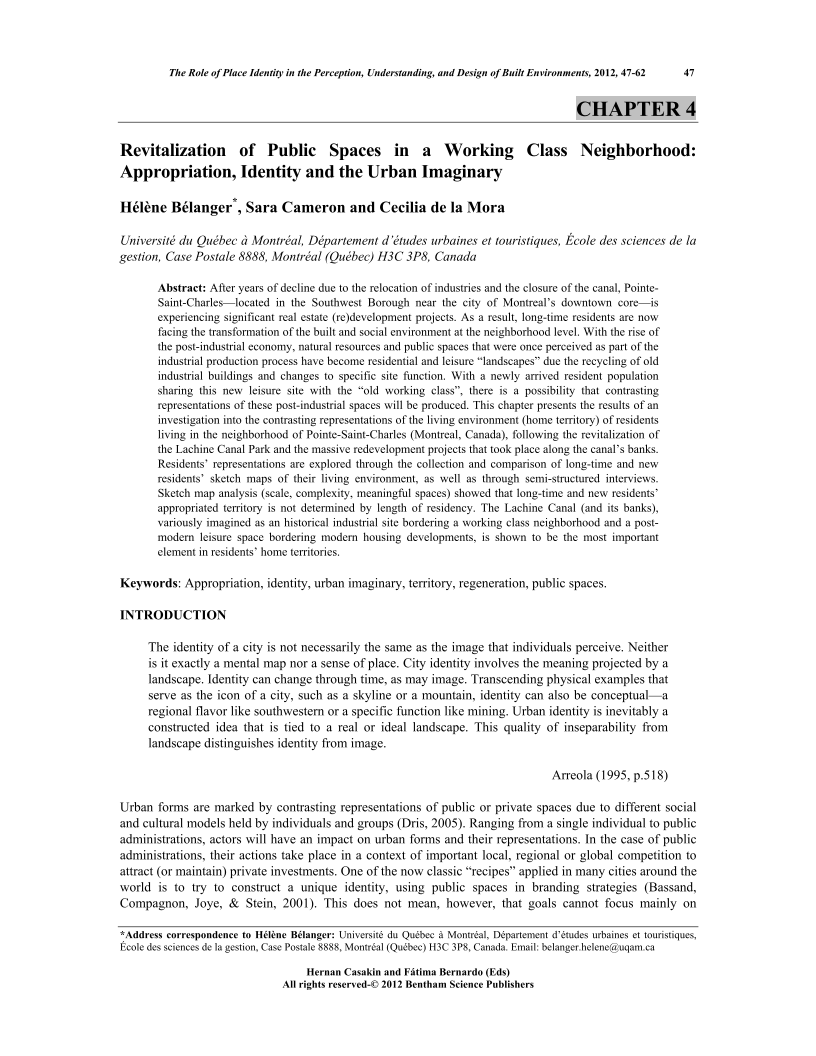Revitalization of Public Spaces in a Working Class Neighborhood: Appropriation, Identity and the Urban Imaginary

- Authors: Hélène Bélanger1, Sara Cameron, Cecilia de la Mora
-
View Affiliations Hide Affiliations1 Universit du Qubec Montral, Dpartement dtudes urbaines et touristiques, cole des sciences de lagestion, Case Postale 8888, Montral (Qubec) H3C 3P8, Canada
- Source: The Role of Place Identity in the Perception, Understanding, and Design of Built Environments , pp 47-62
- Publication Date: July 2012
- Language: English
Revitalization of Public Spaces in a Working Class Neighborhood: Appropriation, Identity and the Urban Imaginary, Page 1 of 1
< Previous page | Next page > /docserver/preview/fulltext/9781608054138/chapter-4-1.gif
After years of decline due to the relocation of industries and the closure of the canal, Pointe- Saint-Charles—located in the Southwest Borough near the city of Montreal’s downtown core—is experiencing significant real estate (re)development projects. As a result, long-time residents are now facing the transformation of the built and social environment at the neighborhood level. With the rise of the post-industrial economy, natural resources and public spaces that were once perceived as part of the industrial production process have become residential and leisure “landscapes” due the recycling of old industrial buildings and changes to specific site function. With a newly arrived resident population sharing this new leisure site with the “old working class”, there is a possibility that contrasting representations of these post-industrial spaces will be produced. This chapter presents the results of an investigation into the contrasting representations of the living environment (home territory) of residents living in the neighborhood of Pointe-Saint-Charles (Montreal, Canada), following the revitalization of the Lachine Canal Park and the massive redevelopment projects that took place along the canal’s banks. Residents’ representations are explored through the collection and comparison of long-time and new residents’ sketch maps of their living environment, as well as through semi-structured interviews. Sketch map analysis (scale, complexity, meaningful spaces) showed that long-time and new residents’ appropriated territory is not determined by length of residency. The Lachine Canal (and its banks), variously imagined as an historical industrial site bordering a working class neighborhood and a postmodern leisure space bordering modern housing developments, is shown to be the most important element in residents’ home territories.
-
From This Site
/content/books/9781608054138.chapter-4dcterms_subject,pub_keyword-contentType:Journal -contentType:Figure -contentType:Table -contentType:SupplementaryData105

